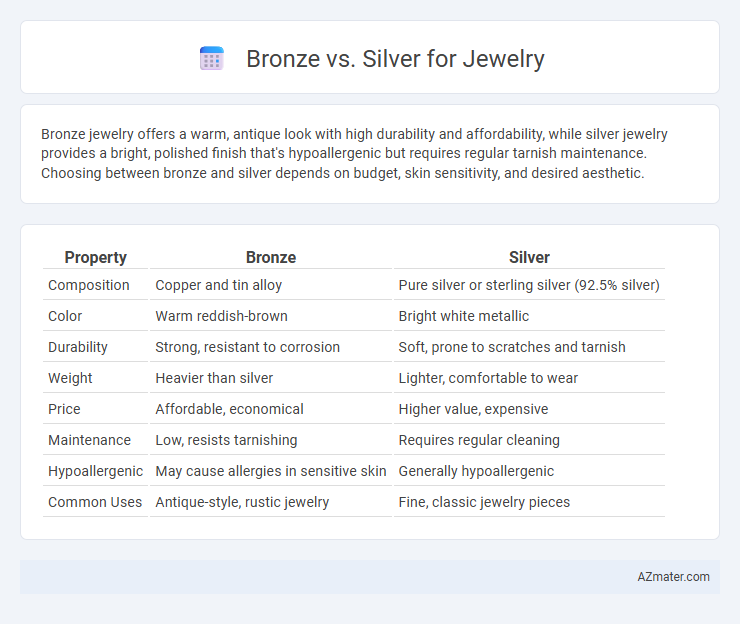Bronze jewelry offers a warm, antique look with high durability and affordability, while silver jewelry provides a bright, polished finish that's hypoallergenic but requires regular tarnish maintenance. Choosing between bronze and silver depends on budget, skin sensitivity, and desired aesthetic.
Table of Comparison
| Property | Bronze | Silver |
|---|---|---|
| Composition | Copper and tin alloy | Pure silver or sterling silver (92.5% silver) |
| Color | Warm reddish-brown | Bright white metallic |
| Durability | Strong, resistant to corrosion | Soft, prone to scratches and tarnish |
| Weight | Heavier than silver | Lighter, comfortable to wear |
| Price | Affordable, economical | Higher value, expensive |
| Maintenance | Low, resists tarnishing | Requires regular cleaning |
| Hypoallergenic | May cause allergies in sensitive skin | Generally hypoallergenic |
| Common Uses | Antique-style, rustic jewelry | Fine, classic jewelry pieces |
Introduction to Bronze and Silver Jewelry
Bronze jewelry, an alloy primarily composed of copper and tin, offers a warm, earthy tone and exceptional durability, making it a popular choice for artisanal and vintage-style designs. Silver jewelry, typically made from sterling silver (92.5% pure silver mixed with copper), is prized for its bright, lustrous finish and versatility across modern and classic styles. Both metals provide unique aesthetic qualities and affordability, catering to varied tastes and occasions in the jewelry market.
Composition and Characteristics
Bronze jewelry consists primarily of copper (about 88%) and tin (around 12%), offering a rich, warm brownish color with good durability and resistance to corrosion. Silver jewelry, mainly composed of 92.5% silver and 7.5% other metals like copper (sterling silver), provides a bright, lustrous appearance but is softer and more prone to tarnishing over time. The choice between bronze and silver depends on desired aesthetics, durability, and maintenance preferences.
Appearance and Aesthetic Appeal
Bronze jewelry offers a warm, reddish-brown hue with a vintage, rustic charm that darkens over time due to patina formation, enhancing its antique appeal. Silver jewelry provides a bright, shiny, and reflective surface, known for its classic elegance and ability to complement both casual and formal wear. While bronze has a more earthy and unique look, silver's timeless brilliance and versatility make it a popular choice for a broad range of aesthetic preferences.
Durability and Longevity
Bronze jewelry offers exceptional durability due to its high copper content, which enhances strength and resistance to wear over time. Silver, while prized for its lustrous appearance, is relatively softer and more prone to scratches and tarnishing, requiring regular maintenance to preserve its finish. For long-term wear, bronze is often favored for its robustness and ability to maintain structural integrity, whereas silver demands more careful handling to sustain its aesthetic appeal.
Hypoallergenic Properties
Bronze jewelry, containing copper and tin, can sometimes cause skin irritation or allergic reactions, especially in individuals sensitive to copper or nickel impurities. Silver, particularly sterling silver (92.5% pure silver mixed with other metals like copper), is generally more hypoallergenic, making it a preferable choice for sensitive skin. However, pure silver or high-quality hypoallergenic silver alloys reduce the risk of allergic reactions compared to bronze alloys with lower purity or those containing nickel.
Tarnishing and Maintenance
Bronze jewelry tends to tarnish faster than silver, developing a greenish patina from oxidation and exposure to moisture and air. Silver, especially sterling silver, requires regular polishing to prevent black tarnish caused by sulfur compounds in the environment. Maintaining bronze involves gentle cleaning and occasional sealing, while silver demands frequent upkeep with polishing cloths and anti-tarnish storage to preserve its shine.
Price Comparison
Bronze jewelry generally offers a more affordable price point compared to silver due to the lower cost of raw materials and simpler manufacturing processes. Silver, especially sterling silver, commands a higher price because of its greater purity, durability, and desirability in the market. While bronze provides cost-effective options ideal for fashion jewelry, silver is favored for investment-worthy pieces with higher resale value.
Popularity and Market Trends
Silver remains more popular in the jewelry market due to its classic appearance and higher perceived value compared to bronze. Bronze jewelry appeals to niche markets with its unique, warm hue and affordability, gaining traction among eco-conscious and artisanal buyers. Market trends indicate a steady demand for silver in fine jewelry, while bronze sees growth in fashion and costume jewelry segments.
Best Uses: Fashion vs. Fine Jewelry
Bronze is ideal for fashion jewelry due to its affordability, durability, and warm, antique look that complements casual and trendy styles. Silver suits fine jewelry best, prized for its bright, lustrous finish and hypoallergenic properties, making it perfect for elegant, timeless pieces. Choosing between bronze and silver depends on the desired aesthetic and budget, with bronze favoring bold, everyday wear and silver serving classic, high-quality designs.
Choosing Between Bronze and Silver
Choosing between bronze and silver for jewelry depends on factors such as durability, appearance, and skin sensitivity. Bronze offers a warm, vintage look and is more affordable, but it can tarnish and cause allergic reactions for some individuals. Silver, especially sterling silver, provides a brighter shine and hypoallergenic properties, making it a popular choice for everyday wear and sensitive skin.

Infographic: Bronze vs Silver for Jewelry
 azmater.com
azmater.com